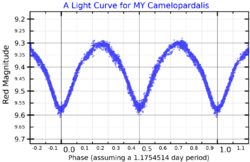Astronomy:MY Camelopardalis
From HandWiki
Short description: Binary star system in the constellation Camelopardalis
| Observation data Equinox J2000.0]] (ICRS) | |
|---|---|
| Constellation | Camelopardalis |
| Right ascension | 03h 59m 18.2863s[2] |
| Declination | +57° 14′ 13.673″[2] |
| Apparent magnitude (V) | 9.80 - 10.15[3] |
| Characteristics | |
| Spectral type | O6nn[4] (O6V((f)) + O6V((f))[5]) |
| U−B color index | −0.66[4] |
| B−V color index | +0.28[4] |
| Variable type | Ellipsoidal[3] |
| Astrometry | |
| Radial velocity (Rv) | −47[1] km/s |
| Proper motion (μ) | RA: −2.3[6] mas/yr Dec.: −0.3[6] mas/yr |
| Parallax (π) | 0.1333 ± 0.0789[7] mas |
| Distance | ~4,000[1] pc |
| Absolute magnitude (MV) | −4.1[4] |
| Orbit[1] | |
| Period (P) | 1.175 days |
| Semi-major axis (a) | 19.24 R☉ |
| Eccentricity (e) | 0 |
| Inclination (i) | 62.59° |
| Argument of periastron (ω) (secondary) | 90° |
| Argument of periapsis (ω) (primary) | 270° |
| Semi-amplitude (K1) (primary) | 335 km/s |
| Semi-amplitude (K2) (secondary) | 400 km/s |
| Details[1] | |
| A | |
| Mass | 37.7 M☉ |
| Radius | 7.60 R☉ |
| Surface gravity (log g) | 4.251 cgs |
| Temperature | 42,000 ± 1,500 K |
| Rotational velocity (v sin i) | 290 km/s |
| B | |
| Mass | 31.6 M☉ |
| Radius | 7.01 R☉ |
| Surface gravity (log g) | 4.245 cgs |
| Temperature | 39,000 ± 1,500 K |
| Rotational velocity (v sin i) | 268 km/s |
| Other designations | |
| Database references | |
| SIMBAD | data |
MY Camelopardalis (MY Cam) is a binary star system located in the Alicante 1 open cluster, some 13 kly (4.0 kpc) away in the constellation Camelopardalis. It is one of the most massive known binary star systems and a leading candidate for a massive star merger. MY Cam is the brightest star in Alicante 1.[1]
The system consists of two hot blue O-type stars with one component having a mass of 32 solar masses and the other 38 solar masses. MY Cam is a contact binary and eclipsing binary, with an orbital period of 1.2 days, and an orbital velocity of 1,000,000 km/h (280 km/s; 620,000 mph).[1] Both stars share a common envelope.[1]
References
- ↑ 1.0 1.1 1.2 1.3 1.4 1.5 1.6 1.7 Lorenzo, J.; Negueruela, I.; Val Baker, A. K. F.; García, M.; Simón-Díaz, S.; Pastor, P.; Méndez Majuelos, M. (2014). "MY Camelopardalis, a very massive merger progenitor". Astronomy & Astrophysics 572: A110. doi:10.1051/0004-6361/201424345. Bibcode: 2014A&A...572A.110L.
- ↑ 2.0 2.1 Hog, E.; Kuzmin, A.; Bastian, U.; Fabricius, C.; Kuimov, K.; Lindegren, L.; Makarov, V. V.; Roeser, S. (1998). "The TYCHO Reference Catalogue". Astronomy and Astrophysics 335: L65. Bibcode: 1998A&A...335L..65H.
- ↑ 3.0 3.1 Kazarovets, E. V.; Samus, N. N.; Durlevich, O. V.; Kireeva, N. N.; Pastukhova, E. N. (2008). "The 79th Name-List of Variable Stars". Information Bulletin on Variable Stars 5863: 1. Bibcode: 2008IBVS.5863....1K.
- ↑ 4.0 4.1 4.2 4.3 Haug, U. (1970). "UBV Observations of luminous stars in three Milky Way fields (Cassiopeia, Camelopardalis and Gemini)". Astronomy & Astrophysics Supplement Series 1 (1): 35. Bibcode: 1970A&AS....1...35H.
- ↑ Greaves, John; Wils, Patrick (2004). "NSV 15852 is likely an Elliptical Variable akin in type to AO Cas". Information Bulletin on Variable Stars 5517: 1. Bibcode: 2004IBVS.5517....1G.
- ↑ 6.0 6.1 Høg, E.; Fabricius, C.; Makarov, V. V.; Urban, S.; Corbin, T.; Wycoff, G.; Bastian, U.; Schwekendiek, P. et al. (2000). "The Tycho-2 catalogue of the 2.5 million brightest stars". Astronomy and Astrophysics 355: L27. doi:10.1888/0333750888/2862. Bibcode: 2000A&A...355L..27H.
- ↑ Brown, A. G. A. (August 2018). "Gaia Data Release 2: Summary of the contents and survey properties". Astronomy & Astrophysics 616: A1. doi:10.1051/0004-6361/201833051. Bibcode: 2018A&A...616A...1G. Gaia DR2 record for this source at VizieR.
 |


